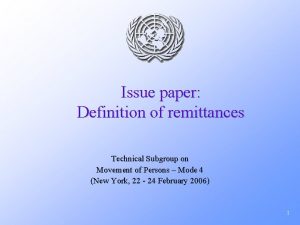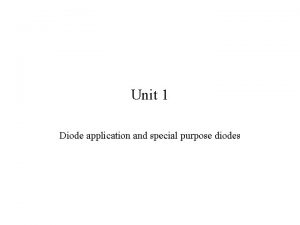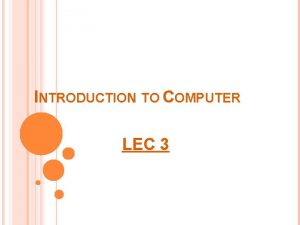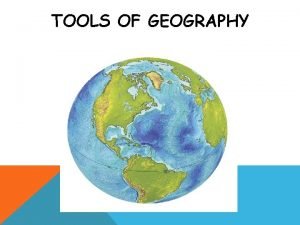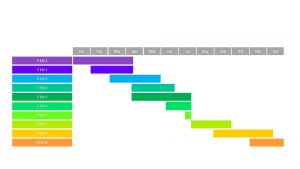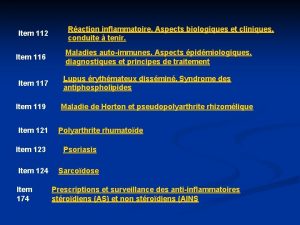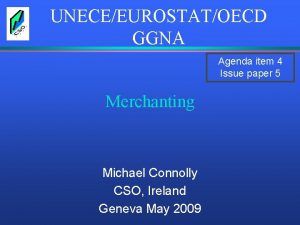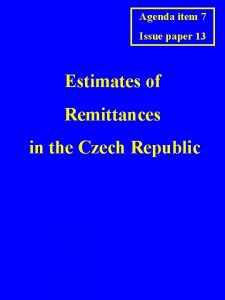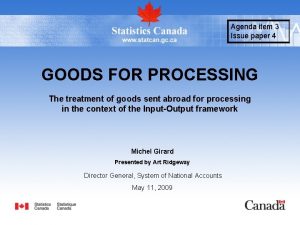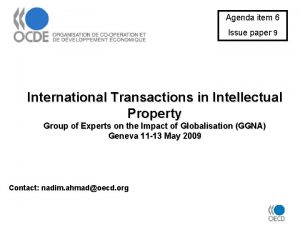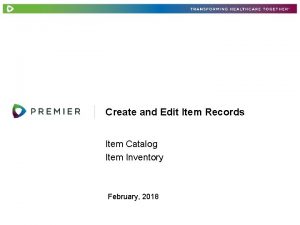Agenda item 8 Issue paper 10 Special Purpose












- Slides: 12

Agenda item 8 Issue paper 10 Special Purpose Entities The Treatment of Special Purpose Entities in the Netherlands GGNA, May 11 th 2009 Bob Groot Statistics Netherlands

Special Purpose Entities (SPEs) 1. 2. 3. 4. 5. 6. Introduction and definition Types of SPEs in the Netherlands SPEs in National Accounts Vulnerabilities in data Questions to members of Expert Group

What are SPEs? SNA 2008: “A number of institutional units may be described as special purpose entities (SPEs) or special purpose vehicles. There is no common definition of an SPE” Paragraph 4. 55

What are Special Purpose Entities (SPEs) ? • Part of multinational company group • Small resident entity • Few employees • Postal box / brass plate • Large financial flows • Attracting financial assets abroad • Re-issuing them abroad • Securities, loans, stocks • (Interceding on behalf of) owner of intellectual property rights

Types of SPEs 1. 2. 3. 4. 5. Financing / Holding companies Royalty & Licence companies Factoring companies Operational lease companies Special purpose vehicles*

SPEs in the Netherlands • How big? • More than 12, 000 SPEs in 2008 • More than 1. 6 trillion euros on closing balance sheet 2008*, approx. 3 x GDP • Low (or negative) value added • Tax gains weigh against costs or loss by SPE • Other industries profit from presence SPEs

SPEs in the Netherlands • How are they identified? • Project group (CBS and DNB) • Decision tree • Criteria to identify SPEs • Different types of SPEs identified • Different criteria for different SPE types • Population delineation between CBS & DNB

SPEs in the Netherlands • How recorded? • Dutch Central Bank (DNB) collects data • • SPEs are obliged to report themselves Monthly surveys on foreign transactions Annual surveys on balance sheet information Bi-annual benchmark investigation • SPEs in National Accounts • Since Benchmark Revision 2001 • Seperate (sub)sector • Data presented including and excluding SPEs

SPEs in National Accounts • Complete set of national accounts data • However: • Available source data have limitations • Not all SPEs report on monthly basis • Necessary assumptions • Little data on domestic transactions

Vulnerabilities in used methods • Problems in estimating Royalties and licence production • The effect on value added by fluctuations in import and export source data • Effect on estimates capital formation • Financial services • Possibly other items booked as financial services in monthly reports by SPEs (e. g. investments in oil platforms)

Vulnerabilities in used methods • Estimates on wages and paid taxes • No direct information by SPEs yet • Population delineation CBS, DNB • Virtually no domestic figures yet

Questions to members of the Group of Experts a) Do members have suggestions for improvement of the methodology on the treatment of SPEs? b) Can the described Dutch decision tree on SPEs also be used in other countries for the detection of SPEs? c) How do members deal with the problems of limited data availability on SPEs? d) Next to the described five types of SPEs, do members have indications for other types of SPEs in their countries?
 Metafora
Metafora Agenda sistemica y agenda institucional
Agenda sistemica y agenda institucional Time magazine future face of america
Time magazine future face of america Issue paper definition
Issue paper definition The definition of news item
The definition of news item English general paper paper 2 comprehension
English general paper paper 2 comprehension What is aice general paper
What is aice general paper Special purpose diode
Special purpose diode Special purpose amplifiers
Special purpose amplifiers 3 computer software
3 computer software Special purpose motors
Special purpose motors Features of 80386 microprocessor
Features of 80386 microprocessor The mix of human and nonhuman features at a given location
The mix of human and nonhuman features at a given location



